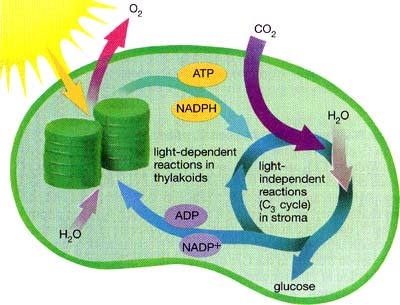What is Light-independent Reaction?
The Calvin cycle
Carbon dioxide fixation
Carbon dioxide reduction
Ribulose bisphosphate regeneration
What is Light-independent Reaction?
The light-independent reaction of photosynthesis is where the ultimate product, glucose, is made. Given its name, the reactions involved in this step do not require light, since the reactants used are taken from the products of the light-dependent reaction. The LIR occurs in the stroma of chloroplasts (the space around thylakoid stacks which contains lots of enzymes involved in photosynthesis).

All LIR events can be viewed as a cycle termed the Calvin cycle. The starting point is carbon dioxide, CO2, and the ending point is glucose (C6H12O6). Before the carbon atoms in CO2 can be incorporated into glucose, a series of events must take place. As you can appreciate, turning a simple inorganic gas into a complex organic molecule which is at the heart of life today as we know it takes just a little bit of magic.
This magic has 3 chapters, as ordered in the Calvin cycle:
- Carbon dioxide fixation
- Carbon dioxide reduction
- Ribulose bisphosphate regeneration
Carbon dioxide fixation
Firstly, carbon dioxide reacts with ribulose bisphosphate waaaaaaaaaaaaaaaaait. Ribulose bisphosphate. Say it out loud. Ribulose bisphosphate. What does it want from you? Nothing, just remember it’s a 5-carbon sugar. Carbon dioxide has 1 carbon, glucose has 6… catch the drift?…..
